 FEUDALISM IN THE
MEDIEVAL WORLD
FEUDALISM IN THE
MEDIEVAL WORLD †††
†††
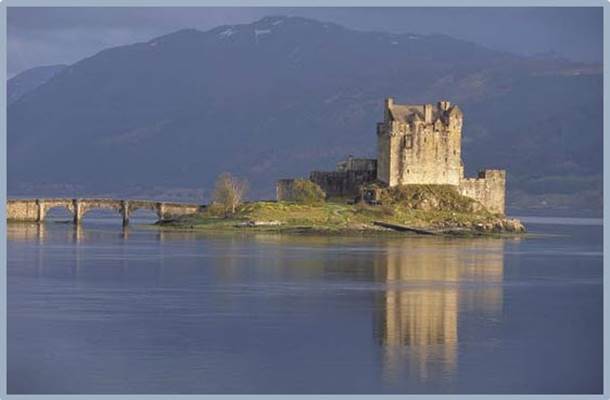
Unit
Overview†††
The
constant invasions that had threatened Western Europe for nearly two hundred
years were over by 1000.† Nonetheless,
they had created strong feelings of fear and insecurity.† People looked for ways to protect themselves
and their property.† This led to
feudalism, a military and political system based on the ownership of land.† Letís see how it all happened.
The
Feudal Contract†††
The
centuries of invasions by German tribes, Magyars and Vikings caused Europeans
to place a high priority on safety and protection.† Kings, who were often weak rulers, exchanged
land for the loyalty of powerful nobles.†
This led to a new military and political system called feudalism.† Under this plan, important nobles or lords
who owned vast amounts of land divided their property among lesser nobles known
as vassals.† In turn, vassals promised to provide service
and loyalty to the greater lords.† This
agreement was referred to as the feudal
contract.† It established a hierarchy, a system in which people
were ranked based on their authority.
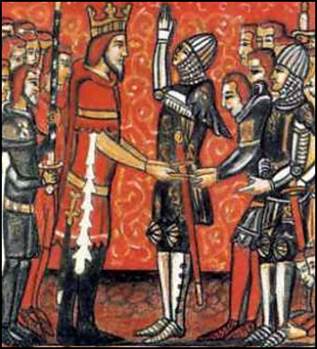
A Vassal Swearing Loyalty to Charlemagne
Under
the terms of the feudal contract, the lord gave the vassal an estate or fief.†
Fiefs, which ranged in size from several square miles to a few acres,
included peasants to farm the land, buildings on the property and villages
within its boundaries.† The lord also
promised to protect the vassal in case of attack.† It was the annual obligation of the vassal to
pay the lord a set amount of money or produce and to provide forty days of
service.† When the lordís oldest son
became a knight or his daughter married, vassals were expected to contribute to
the celebrations that accompanied these events.†
When traveling, a lord and those with him could stay at vassalís
fief.† The vassal had to be prepared to
offer housing and dining for several days in this situation.† If the lord was captured in battle and held
for ransom, his vassals were duty-bound to pay for his freedom.
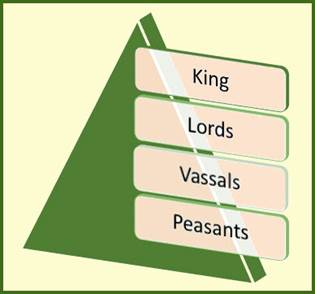
The
Feudal Hierarchy
Knights
and Castles†††
Competition
for power among the great lords was intense.†
This rivalry made warfare a way of life during the Middle Ages and
encouraged many men to become warriors on horseback or knights.† A boy began his
training for knighthood at the age of seven and was sent to live in the castle
of his fatherís lord.† The training that
a would-be knight received was strict and demanding.† Candidates learned to ride, to fight and to
keep their armor and weapons in good condition.†
After an official ceremony called a dubbing,
those who had completed their instruction took their places alongside the
lordís other men.† To keep their skills
sharp, lords often invited the knights to participate in tournaments and awarded prizes to the victors.† Although knights were expected to kill their
enemies in battle, they were required to follow a code of conduct called chivalry.† It stressed that knights be loyal and kind as
well as brave.† According the chivalryís
guidelines, they were obligated to protect women and to treat prisoners of war
fairly.†
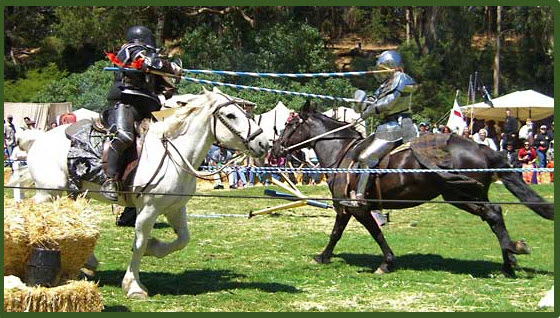
A
Reenactment of a Medieval Tournament
During
the early Middle Ages, knights followed the Roman method of dressing for
battle.† They wore protective gear made
from leather or chain mail, which
was composed of small, interlocking metal rings.† Neither leather nor chain mail, however,
could prevent the penetration of a sharp-pointed weapon, such as a lance or
javelin.† †As metalworking technology improved, the use
of plate armor became popular.† Although
it was expensive and heavy, it offered protection from cuts and stab
wounds.† Because it could be shaped as
separate pieces that covered every area of the body, it was possible to walk
and to ride while wearing it.† Plate
metal even shielded horses from harm.† By
the end of the Middle Ages, suits of armor were obsolete because they were no
match for firearms, the next development in weaponry.††
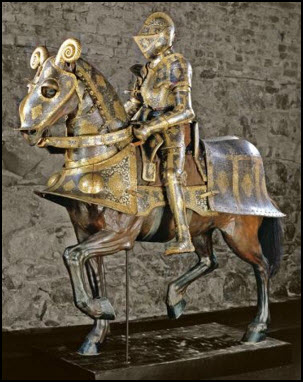
Medieval Armor for Knight and Horse
The
desire for security led the lords to fortify their homes in case of
attack.† At first, they simply added a
tower or a keep, a fence and a ditch
filled with water for defense.†
Eventually, these simple structures grew into large and grand
castles.† They were protected by high,
stone walls, several towers and a drawbridge that could be lowered over a wide,
deep moat.† The objective of a battle was often to seize
the castle of another lord, especially if it was located near a harbor or
mountain pass.† Castles were sometimes
surrounded and held under siege for weeks at a time.† Although most of us have dreamed of living in
a castle at one time or another, they were not very comfortable.† Most of these structures were cold, dreary
and damp.
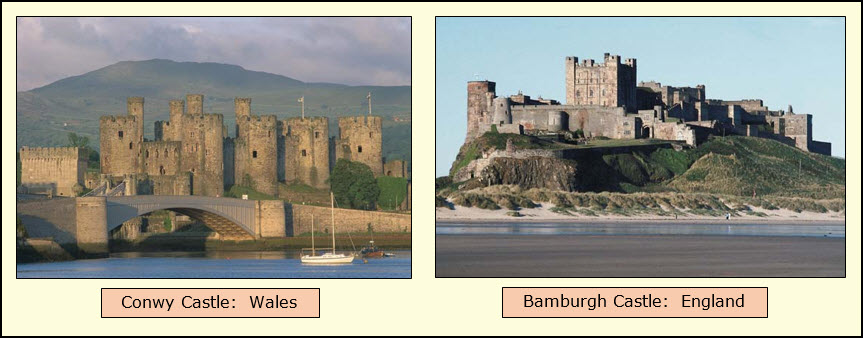
Manors
and Serfs†††
The
lordís castle or manor house, nearby villages and surrounding lands were all
part of his estate or manor.† Peasants,
also referred to as serfs, made up
the majority of the population during the Middle Ages.† They lived and worked on the property.† Because money had almost ceased to exist in
medieval Europe, they paid their rent with a portion of the crops that they
grew or the animals that they raised.†
The peasants were obligated to work the lordís farmland for a specified
number of days each week.† The repair of
the estateís roads, bridges and fences was also part of their feudal
contract.† In addition, peasants gave up even
more of what they produced for getting married, inheriting property and
grinding grain in the lordís mill.† In
exchange, they received the lordís protection and the right to plant a few
acres of land for themselves.† The idea
of trading goods or services for other goods and services was called bartering.† It was the chief method of conducting
business during the Medieval Period.
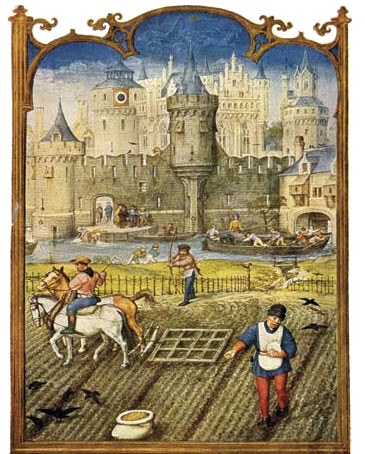
Peasants Working in the Fields during the Middle
Ages
Most
peasants were viewed as part of the estate and could not leave without the
lordís permission.† Since peasants
produced almost every necessity, each manor was generally self-sufficient.† Food, furniture, tools and clothing were all
made locally.† Most serfs knew nothing of
the world beyond their village.† Their
community consisted of small, one-room huts, a church and a mill for grinding
grain.† The nearby fields were divided
into narrow strips of land, and families were assigned several of these in
different fields.† This way, a serf did
not have all his land in a field that was less productive.† For the most part, peasants struggled just to
survive, and most did not live beyond the age of thirty-five.† There were a few peasants that were considered
free men.† They had fewer obligations to
the lord and could leave the manor when they wished.† However, one bad harvest or flood sometimes
forced a free man into debt with his lord.
Women:† Noble and Peasant†††
Although
they lived in a world dominated by men, women played a role in feudal
society.† Because their husbands and
fathers were of the called to battle, noblewomen ran the manors during their
absence.† They held the vassals accountable
for their obligations, supervised the household and prepared for the defense of
the castle, if necessary.† Because
property was usually passed down to the oldest son in the family, women seldom
inherited land.† Fathers negotiated
arranged marriages for their daughters.†
These unions were based on financial and political advantage rather than
romantic ties.† Most noblewomen who did
not marry entered convents and became nuns.†
For peasant women, life was especially hard.† They usually worked long hours in the fields
with their husbands and helped fulfill the obligations of their families to the
lords.† At the same time, these women
cared for their children, cooked meals from whatever foods were available and
looked after the familyís livestock.† Very
few European women, noble or peasant, could read or write at this time.
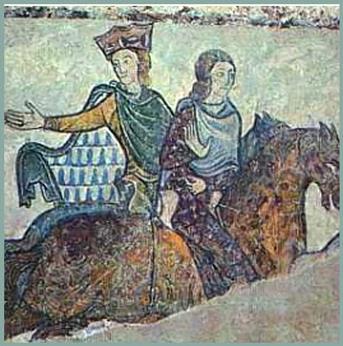
A Mural Picturing Eleanor of Aquitaine and
One of her Sons
Although
the medieval life was dominated by men, there were some influential women.† Eleanor
of Aquitaine first married King
Louis VII of France. This was an arranged marriage, and the couple had
little in common.† To further complicate
matters, Louis wanted a male heir, but Eleanor had given him two
daughters.† They divorced, and the former
queen quickly became engaged to the man who was to become Henry II, king of England.†
They were the parents of eight children, five boys and three girls.† The queen plotted with her sons to overthrow
King Henry.† The rebellion was not
successful, and Eleanor spent the next fifteen years in prison.† After Henryís death, her son Richard became the next king of
England.† He immediately freed his
mother, and she ruled in his place when he was fighting wars outside the
country.†† At a time when women had few
rights and little political influence, Eleanor of Aquitaine was an exceptional
woman.
What
Happened Next?††††
The
feudal system and its harsh realities were familiar aspects of the Middle Ages,
but the era was also sometimes called the Age of Faith.† The medieval Church shaped the lives and
thoughts of Europeans through its teachings, but it also became the most
influential force of its time.† Great
Romanesque and Gothic cathedrals were built across the European landscape and
served as a reminder of the Churchís power.†
Before looking at this topic in more detail in the next unit, review the
names and terms from Unit 14; then, complete Questions 21 through 30.